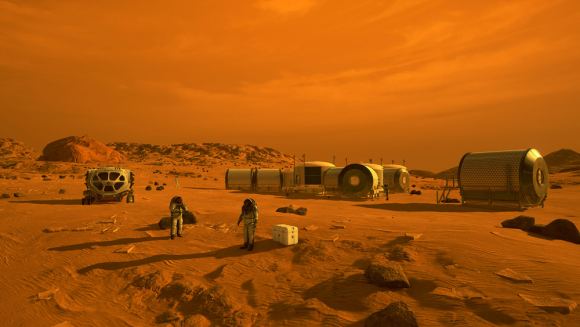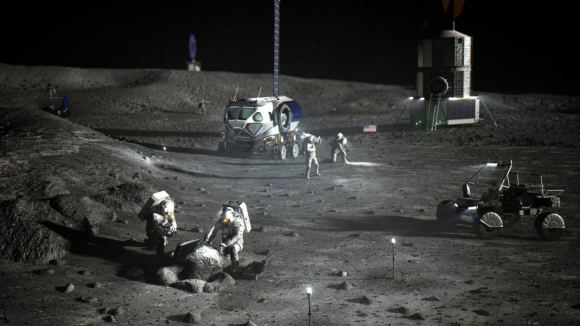Going to Mars is a major step in space exploration. It's not a quick jaunt nor will it be easy to accomplish. The trip is already in the planning stages, and there's a good chance it'll happen in the next decade or so. That's why NASA and other agencies have detailed mission scenarios in place, starting with trips to the Moon. Recently, NASA updated its "Moon to Mars Architecture" documents, including a closer look at some key decisions about Mars exploration.
Those decisions cover a wide gamut of challenges to living and working on the Red Planet. NASA planners narrowed them down to these key areas: science priorities, number of crew members on the first trip, how many on each follow-up trip, number of crew members per Mars location, Mars surface power generation technologies, what kinds of missions will be sent (the "target state"), and establishing what they call a "loss of crew risk" posture. That last one involves making the right decisions about missions based on risk to the crew's health and performance.
NASA Plans for the Moon and Mars
Why create a mission architecture for the Moon and Mars? Essentially, anybody going to these other worlds needs a mutually agreed-upon "roadmap" that plans the explorations and technologies needed. That's why NASA created its first Moon to Mars objectives in 2022 and has been refining them ever since. The agency's roadmap includes feedback from a wide swath of society. Members of academia, U.S. industry, international partners, and the NASA workforce all contributed to the project.
"Our new documents reflect the progress we've made to define a clear approach to exploration and lay out how we'll incorporate new elements as technologies and capabilities in the U.S. and abroad mature," said Catherine Koerner, associate administrator, Exploration Systems Development Mission Directorate at NASA Headquarters in Washington. "This process is ensuring that everything we are doing as an agency and together with our partners is focused on achieving our overarching exploration goals for the benefit of all."
The Key Decisions Regarding Mars Exploration
In a white paper published along with the Moon to Mars Architecture document, NASA explains key areas of concern when it comes specifically to Mars exploration. The first is science. It's the main reason for going the both the Moon and Mars, and its needs will drive almost all other considerations. It will determine the resources needed, including crew numbers, payloads, technology deliveries, and power and communications infrastructure, and contingencies for possible accidents or other challenges.
Once the science is determined, planners can decide on crew needs for the first and subsequent missions. As the white paper states, "…a series of focused science exploration missions to different landing sites would favor one architecture. Establishing a permanent, fixed base from which astronauts could conduct many surface missions supporting diverse and evolving exploration activities would favor a very different architecture."
From there, planners will figure out the "cadence" of the missions and crew deployments. How often do we send missions and how many people will go? Just as an example, let's say that the first mission will land in Jezero Crater, near the Perseverance rover. NASA could use its data to determine further science exploration at the site. That will drive the best placement for habitats and other infrastructure, and the type of mission will dictate the number of crew members needed.
Those decisions will then drive the infrastructure and technology needed for each step. Science stations need power to do the science, but also to sustain the habitats for the science teams. If those teams travel across the surface, their rovers will need power, fuel, and possibly replacement parts. Crew members themselves will need to be able to grow food, use local resources to extract fuel and water, and otherwise maintain safe living conditions. And, these are just the first steps in the long-term exploration of Mars, enabled by what people learn about living and working on the Moon.
Why Does NASA Want a Moon to Mars Plan?
While it may seem sexy to send people directly to Mars without any intervening stops at the Moon, NASA and other agencies want a measured approach. The idea to use the Moon as a stepping stone to Mars is not new. The Moon makes a good "training base" of sorts where we can "practice" with the technologies and techniques of living on another world. In addition, it offers a unique environment for astronomy and planetary science exploration. Astronauts learn in an environment close to Earth and if something dire happens to them, rescue is not far away.
These ideas underlie the planning for the upcoming Artemis missions to the lunar surface. There's supposed to be a gateway orbiting the Moon, to which astronauts and equipment will fly. Then, from there, materials and people head to the Moon to explore various sites, and begin the complex tasks of exploration and habitat construction. That set of missions will establish the foundation for scientific exploration, and land a diverse set of people on the lunar surface, all in cooperation with international partners. Ultimately, everything they learn on the Moon will prepare people for the leap to Mars.
The Moon to Mars mission architectural plans unite both lunar and Mars exploration in one timeline, identifying technologies and capabilities needed to accomplish each step. They are living documents, updated every year to reflect changes in any aspect of mission planning and technology.
For More Information
NASA Shares Newest Results of Moon to Mars Architecture Concept Review
Moon to Mars Architecture
Key Mars Architecture Decisions (PDF)
 Universe Today
Universe Today


